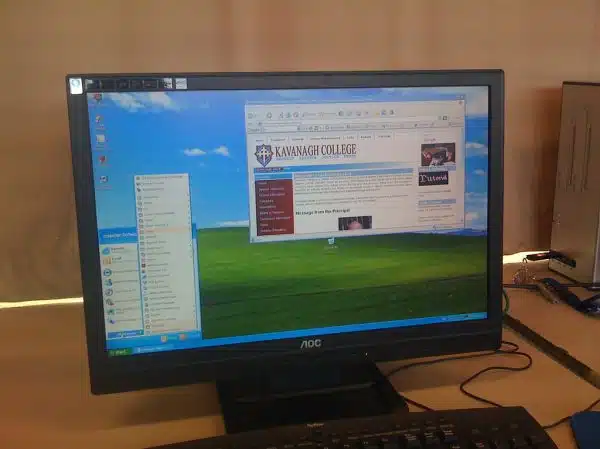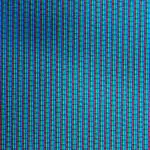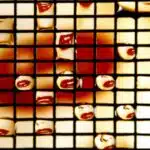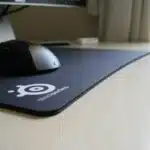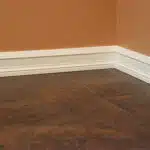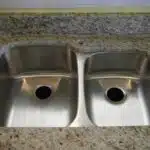As a computer repair technician, one of the most common issues that I encounter is dirty and smudged computer monitors. A clean monitor not only enhances the overall appearance of the device but also ensures a clear and comfortable viewing experience for the user. However, cleaning a monitor can be a daunting task, especially for those who are new to it. In this article, we will discuss the proper way to clean a computer monitor to ensure its longevity and optimal performance.
Before starting the cleaning process, it is essential to understand that improper cleaning techniques can damage your monitor permanently. It is crucial to use appropriate cleaning materials and avoid using harsh chemicals or rough materials that can scratch or leave marks on your screen. Moreover, you need to know how frequently you should clean your monitor according to its usage patterns and environmental factors such as dust and humidity levels. By following these guidelines, you can keep your computer monitor in top shape while ensuring an excellent visual experience every time you use it.
Understanding The Importance Of Cleaning Your Computer Monitor
Have you ever experienced eye strain or headaches after using your computer for an extended period? Do you find yourself constantly adjusting your sitting position in order to view your screen more comfortably? These issues could be a result of neglecting to clean your computer monitor. Understanding the importance of cleaning your computer monitor goes beyond simply maintaining its appearance. It can also have significant ergonomic benefits and reduce eye strain, which ultimately leads to greater productivity.
Research has shown that a clean monitor can help alleviate physical discomfort caused by prolonged computer use. When dust, dirt, and smudges accumulate on the screen, it can cause glare and reflections that force users to adjust their posture or lean in closer to read text. This can lead to neck and back pain, as well as eyestrain. By regularly cleaning your monitor, you can reduce these physical symptoms and improve overall comfort during prolonged periods of computer use.
Furthermore, a clean monitor is crucial for reducing eye strain. When dirt and dust accumulate on your screen, it filters out light from the display, resulting in poor image quality. As a result, your eyes work harder than necessary to focus on text or images displayed on the screen. Over time, this constant eye strain can cause vision problems such as nearsightedness or farsightedness. By properly cleaning your monitor, you can ensure that it displays images clearly and accurately without placing unnecessary stress on your eyesight.
To begin cleaning your monitor effectively, the first step is identifying the type of monitor you have…
Identifying The Type Of Monitor You Have
Before you begin cleaning your computer monitor, it is essential to identify what type of monitor you have. There are different types of monitors available in the market, and each one requires a unique cleaning process. Identifying the monitor’s type will help you determine which cleaning method to use.
One way to identify your monitor type is by checking the manufacturer’s label on the back or bottom of the screen. The label usually includes information about the model number, serial number, and other details that can help you determine what type of monitor you have. If there are no labels available, you can try searching for your model online or contacting customer support for assistance.
Troubleshooting monitor issues is also an excellent way to determine what type of monitor you have. Most monitors come with specific troubleshooting procedures that can help diagnose any problems with your device. Through these procedures, you can identify technical specifications such as resolution and refresh rate, which can also provide insights into what type of monitor you own.
In summary, identifying your monitor’s type is crucial before starting any cleaning process. By knowing your device’s specifications and technical details, you can ensure that you choose the appropriate cleaning method that won’t cause damage to your screen. In the next section, we will discuss how to gather necessary cleaning materials to make sure that your computer screen is sparkling clean without any scratches or damages.
Gathering The Necessary Cleaning Materials
As a computer repair technician, I have seen countless monitors that have become damaged due to improper cleaning methods. Choosing the appropriate cleaning materials is crucial in maintaining the longevity of your monitor. Firstly, avoid using paper towels or tissues as they can scratch the surface of your monitor. Instead, opt for a microfiber cloth which is specifically designed for cleaning electronic devices. If you cannot find one, use a clean and soft cloth.
Another common mistake people make when cleaning their monitors is using harsh chemicals such as ammonia or alcohol-based solutions. These chemicals can strip away the protective coating on your monitor and cause permanent damage. It’s best to use a gentle cleaner specifically formulated for electronics to ensure that you don’t cause any harm.
To summarize, choosing appropriate cleaning materials and avoiding common mistakes are crucial factors in keeping your monitor clean and functioning properly. By using a microfiber cloth and gentle cleaner specifically formulated for electronics, you can ensure that you’re not causing any damage while still effectively removing dirt and grime from your monitor surface. In the next section, we will discuss turning off your monitor and disconnecting cables before beginning the cleaning process to avoid any accidents or damage during cleaning.
Turning Off Your Monitor And Disconnecting Cables
Turning off your monitor and disconnecting cables are important steps in the cleaning process. Before you begin, make sure that your computer is turned off and unplugged for safety reasons. Once this is done, you can proceed with cleaning the monitor without worrying about any electrical hazards.
Regular cleaning of your computer monitor is crucial to maintaining its performance and longevity. Over time, dust and debris can accumulate on the screen, which can affect the image quality and cause eye strain. By keeping your monitor clean, you’ll be able to enjoy a clearer picture and reduce eye fatigue. It’s recommended that you clean your monitor at least once a month to prevent buildup.
Proper storage of cables is also important when cleaning your monitor. Make sure that all cables are disconnected from both the computer and the monitor before cleaning. You can store them neatly in a designated area so that they don’t get tangled or damaged during the process. This will not only make it easier for you to clean but also prevent any potential damage to your cables.
Before moving on to removing dust and debris from your monitor, it’s crucial that you turn off the power supply completely and unplug all cords from their sockets. This ensures that no electrical current runs through the system while cleaning, preventing any possible harm or short circuits. Now that we have covered these steps let’s move on to removing dust and debris from your monitor.
Removing Dust And Debris From Your Monitor
Keeping your computer monitor free from dust and debris is essential to maintain its longevity. Over time, dust, fingerprints, and other debris can accumulate on your screen, making it difficult to view images or text clearly. To prevent this buildup, you need to know how to remove the dust and debris effectively.
Using compressed air is an excellent way to remove dust particles from your monitor without damaging it. Compressed air products are readily available in most computer stores or online retailers. When you use compressed air, be sure to hold the can upright and never tilt it sideways or upside down as this can release liquid that may damage the screen. Aim at a distance of approximately six inches from the surface of your monitor while spraying in short bursts.
Wiping with alcohol is another effective method for removing stubborn debris from your monitor’s surface. Alcohol solutions evaporate quickly and leave no residue behind that may attract more dirt particles. Be sure to use a soft microfiber cloth or lint-free cloth when wiping down your screen with alcohol. You can also find anti-static solutions that will help prevent future buildup on your monitor by neutralizing electrical charges that attract dust particles.
Use compressed air cans to blow away any visible dust particles.
Make sure you hold the can upright while spraying short bursts.
Aim at a distance of six inches away from the screen.
Wipe down the surface with an alcohol solution.
Use a soft microfiber cloth for best results.
Anti-static solutions are available that will help prevent future buildup by neutralizing electrical charges that attract dust particles.
By following these simple steps for removing dust and debris from your monitor’s surface, you can keep it clean and clear for optimal viewing. In the next section, we’ll discuss how to clean your monitor using a microfiber cloth without causing any damage or leaving streaks on its surface.
Cleaning Your Monitor With A Microfiber Cloth
To clean your computer monitor properly, it is recommended to use a microfiber cloth. This type of cloth is designed to gently remove dirt and smudges from the screen without leaving any scratches. It is important to avoid using paper towels or other rough materials as they can damage the surface of the monitor.
Cleaning frequency is also an essential aspect to keep in mind when cleaning your monitor. Depending on how often you use your computer, it is recommended to clean your monitor at least once a week. If you notice any buildup of dust or fingerprints, it may be necessary to clean it more frequently. Regular cleaning not only helps maintain the appearance of the screen but also prevents the accumulation of harmful bacteria.
In addition to using a microfiber cloth, there are alternative cleaning methods that you can consider. Some people prefer using a soft-bristled brush or compressed air canister to remove dust particles from hard-to-reach areas. However, it is crucial not to apply too much pressure while using these methods as they can cause damage to delicate components. Always ensure you follow proper procedures when exploring alternative cleaning methods.
When using a gentle cleaning solution, there are specific steps you should follow for optimal results. By following these guidelines, you will not only protect your monitor’s surface but also extend its lifespan significantly.
Using A Gentle Cleaning Solution
To ensure a clean and clear monitor, it is recommended to use a gentle cleaning solution that is non-toxic. Creating your own cleaning solution can be quick and easy by mixing equal parts distilled water and white vinegar. This mixture is effective in removing dirt, smudges, and fingerprints without damaging the monitor. It is important to avoid using harsh chemicals such as bleach or ammonia as they can cause damage to the screen.
Using a spray bottle for easier application of the cleaning solution can be beneficial. The mist from the spray bottle will help to distribute the solution evenly across the monitor’s surface area. Spray the solution onto a microfiber cloth rather than directly onto the screen to prevent any liquid from seeping into any openings or crevices on the monitor. A microfiber cloth is best used for wiping down computer monitors as it does not leave behind any lint or scratches.
Overall, creating a non-toxic cleaning solution and using a spray bottle are simple steps that can make all the difference when it comes to maintaining a clean computer monitor. In addition to avoiding harsh chemicals, it is also important to avoid using rough materials such as paper towels or tissues when wiping down your computer screen. In the next section, we will discuss how to properly select materials that won’t scratch or damage your monitor while still allowing you to achieve optimal cleanliness.
Avoiding Harsh Chemicals And Rough Materials
Have you ever experienced the frustration of trying to clean your computer monitor with harsh chemicals only to realize that it left streaks and smudges? The use of harsh chemicals and rough materials can not only damage your monitor, but it can also be harmful to the environment. As a responsible computer repair technician, it is important to educate users on alternative cleaning methods that are safe for both their monitors and the environment.
One alternative method is the use of eco-friendly cleaners. These cleaners are made from natural ingredients such as vinegar, lemon juice, or baking soda. Not only are they gentle on your monitor, but they are also non-toxic and biodegradable. These eco-friendly cleaners can easily remove dirt, dust, and fingerprints from your screen without leaving any residue behind.
Another method to avoid harsh chemicals and rough materials is by using microfiber cloths. These cloths are specifically designed for cleaning delicate surfaces like computer monitors. They are soft, lint-free, and do not scratch the surface of your monitor. When using a microfiber cloth, it is important to avoid applying too much pressure as this can damage your screen.
Now that you know about alternative cleaning methods and eco-friendly cleaners, you can keep your computer monitor looking clean without causing harm to yourself or the environment. In the next section, we will discuss how to clean your monitor stand and base using similar gentle methods. By taking care of all elements of your computer setup in an eco-friendly way, you will be doing your part in creating a sustainable future for us all.
Cleaning Your Monitor Stand And Base
To continue our discussion on how to clean a computer monitor, it is essential to note that cleaning the monitor stand and base is equally important. Just like the monitor screen, dust and dirt can accumulate on the stand and base over time. To clean these areas, use a microfiber cloth or a soft-bristled brush to remove any dust or debris. If there are any stubborn stains, use a mild detergent solution with warm water.
Another area that needs attention when cleaning your computer monitor is the cables. Cables tend to collect dust and dirt, which can affect their performance. Before cleaning the cables, ensure that they are unplugged from the power source and disconnected from the computer. Use a dry cloth or a soft-bristled brush to remove any loose debris before wiping them down with a damp cloth.
When cleaning your computer monitor, it is crucial to take measures that prevent scratches on its surface. Avoid using rough materials such as paper towels or tissues as they can cause scratches on the screen. Instead, opt for a microfiber cloth as it is soft and gentle on the surface of your monitor. Additionally, avoid using harsh chemicals such as ammonia-based cleaners as they can damage the protective coating on your screen.
Now that you know how to clean your computer monitor properly let us discuss how often you should do it. The frequency of cleaning your monitor depends on various factors such as usage and environment. If you use your computer regularly or in dusty environments, you should clean your monitor once every week using the steps outlined above. However, if you use your computer less frequently or in less dusty environments, then once every month should suffice. Remember; regular cleaning ensures that your monitor stays in good condition for longer periods while preventing damage caused by neglecting its maintenance needs.
How Often Should You Clean Your Monitor?
It is imperative to maintain cleanliness and hygiene in the workplace, especially when it comes to computer monitors. The frequency of cleaning your monitor depends on several factors such as the type of environment you work in, how often you use your computer, and whether or not you eat at your desk. It is best practice to clean your monitor at regular intervals to avoid buildup of dust and debris.
To help keep your monitor clean and functioning optimally, we recommend the following:
- Avoid touching the screen with your fingers
- Use a microfiber cloth for cleaning
- Avoid using harsh chemicals or abrasive materials
- Turn off your monitor before cleaning
By adhering to these best practices, you can ensure that your monitor stays clean and clear, which will not only enhance its performance but also prolong its lifespan.
In conclusion, maintaining a clean monitor is critical for improving visibility and preventing eye strain. As a computer repair technician, I have seen many cases where neglecting to clean a monitor has resulted in decreased functionality and even permanent damage. Therefore, it is essential to make cleaning your monitor a routine part of your workspace maintenance. In the next section, we will provide tips for maintaining a clean monitor that will help you keep yours looking spotless.
Tips For Maintaining A Clean Monitor
The accumulation of dust on a computer monitor can cause performance issues and can be detrimental to the overall health of the device.
To remove dust from a monitor, use a soft and lint-free cloth or a compressed air canister to gently wipe away any particles.
For more stubborn dirt and debris, specialized screen wipes are available to safely clean the surface of a monitor.
It is important to never use any harsh chemicals or abrasive materials to clean a computer monitor to avoid potentially damaging the device.
Dust Removal
Dust buildup on computer monitors is a common problem that can affect the overall performance of the device. As a computer repair technician, it is my responsibility to provide tips and tricks to help users maintain a clean monitor. One effective way to remove dust from your monitor is by using compressed air or vacuum.
Compressed air is an excellent tool for removing dust particles from your computer monitor. It can effectively blow away any dirt, debris, or other contaminants that may have accumulated on the screen over time. However, it’s important to use compressed air correctly, as excessive pressure can damage the delicate components inside the monitor. Alternatively, you could use a vacuum cleaner with a soft brush attachment to remove any visible dust or debris without damaging the screen.
Preventing dust buildup on your monitor is also essential in maintaining its cleanliness. Simple tips and tricks such as placing your monitor away from windows and avoiding smoking near it can go a long way in reducing dust accumulation. Additionally, wiping down your screen with a microfiber cloth regularly can prevent dust from settling in between the pixels of your display.
In conclusion, removing dust from your computer monitor is crucial in ensuring its longevity and optimal performance. Whether you choose to use compressed air or vacuum for cleaning purposes, it’s essential to exercise caution while handling delicate electronic components. Remembering simple tips and tricks like preventing dust buildup will also help keep your device clean and functional for years to come.
Screen Wipes
Maintaining a clean monitor is essential in ensuring optimal performance and longevity. While compressed air and vacuuming are effective ways to remove dust buildup, there are other eco-friendly alternatives that users can opt for. One such alternative is the use of screen wipes, which are pre-moistened cloths specially designed for cleaning computer screens.
Screen wipes come in various forms, including disposable and reusable options. They are gentle on the screen surface and do not leave streaks or residue behind. Additionally, they are convenient to use and can be easily stored in your desk drawer or laptop bag. For those who prefer DIY solutions, there are also numerous recipes available online for making your own screen wipes using household ingredients.
Using screen wipes is an excellent way to maintain a clean monitor without harming the environment or spending a lot of money on expensive cleaning products. They are suitable for all types of monitors, including LCDs and LEDs, and can also be used to clean other electronic devices like smartphones and tablets. By incorporating this simple tip into your routine, you can ensure that your device remains functional and efficient for years to come.
Dealing With Stubborn Stains And Marks
Maintaining a clean monitor is crucial to ensure optimal viewing experience and prolong the lifespan of your computer screen. However, sometimes regular cleaning methods may not be enough to remove stubborn stains and marks from your monitor. In this section, we will provide tips on how to deal with these persistent blemishes.
Removing stubborn stains from your monitor can be a challenging task, but there are several effective methods you can try. For instance, you can use a microfiber cloth dipped in warm soapy water or rubbing alcohol to gently scrub the affected area. Alternatively, you can opt for specialized cleaning solutions designed for monitors that are available in most electronic stores. These solutions are formulated to dissolve tough stains without damaging your screen’s coating.
In addition to removing stubborn stains, it is essential to take preventive measures to avoid future marks on your monitor. One way to do this is by avoiding touching your screen with bare hands or dirty objects such as pens or markers. You can also invest in a protective cover or film that acts as a barrier against dust and other particles that can leave marks on your screen. By implementing these preventive measures, you can significantly reduce the need for deep cleaning and prolong the lifespan of your monitor.
Transitioning into the subsequent section about troubleshooting common monitor cleaning issues: While these tips should help you tackle most stain-related problems, there may still be instances where traditional cleaning methods fall short. In the next section, we will discuss some common challenges that arise during monitor cleaning and provide troubleshooting advice on how to overcome them.
Troubleshooting Common Monitor Cleaning Issues
When it comes to cleaning computer monitors, there are several common misconceptions that people have. For example, some believe that using glass cleaner or other household cleaners is safe for their monitor. However, these products often contain harsh chemicals that can damage the screen’s coating and cause permanent discoloration. Another misconception is that wiping the screen with a dry cloth will remove all dust and debris. In reality, this can scratch the surface of the monitor and make it more difficult to clean in the future.
To prevent future cleaning needs, it’s important to take preventative measures when using your computer. For example, avoid eating or drinking near your computer to minimize spills that could damage the screen. Additionally, keep your computer away from areas where dust and debris are prevalent, such as near a window or in a workshop environment. By taking these simple steps, you can reduce the amount of cleaning required and extend the lifespan of your computer monitor.
In summary, understanding how to properly clean your computer monitor is crucial for maintaining its longevity and preventing damage. By avoiding common misconceptions about monitor cleaning and taking preventative measures to reduce future cleaning needs, you can ensure that your monitor stays in top condition for years to come. However, if you do encounter issues with your monitor despite these efforts, there are still steps you can take to address the problem – read on for more information about what to do if your monitor gets damaged.
What To Do If Your Monitor Gets Damaged
If your computer monitor has suffered damage, there are a few repair options available to you. The first option is to contact the manufacturer of your monitor and see if it is still under warranty. If it is, they may be able to repair or replace it for free or at a reduced cost. If your warranty has expired, you can take your monitor to a local repair shop or send it in to a third-party repair service.
Prevention is always better than cure when it comes to protecting your computer monitor from damage. There are several steps you can take to prevent damage from occurring in the first place. First and foremost, make sure that you handle your monitor with care when moving it or adjusting its position. Always use two hands when lifting it and avoid putting pressure on the screen itself. Additionally, keep your work area clean and dust-free as dust particles can scratch the surface of your screen over time.
In summary, there are various repair options available if your monitor gets damaged including contacting the manufacturer or taking it to a professional repair service. However, prevention is key when it comes to protecting your monitor from damage so be mindful of how you handle and maintain it. By following these prevention tips, you can keep your monitor clean and pristine for years to come.
Conclusion: Keeping Your Monitor Clean And Pristine
Keeping your computer monitor clean is essential for maintaining its longevity and ensuring that it functions properly. While a dirty screen might not seem like a big deal, it can cause significant damage over time. Thankfully, there are several tips you can follow to prevent this from happening.
Firstly, be sure to avoid exposing your monitor to direct sunlight or other sources of extreme heat or cold. This can cause the screen to warp or crack, leading to permanent damage. Additionally, try to keep your monitor away from any potential hazards such as water or other liquids that could spill on it.
When it comes to cleaning a touch screen monitor, it’s important to use safe practices that won’t damage the screen. Avoid using abrasive materials such as paper towels or rough cloths that could scratch the surface. Instead, opt for a soft microfiber cloth or specialized cleaning solution designed specifically for touch screens. Also, be sure to turn off the monitor before cleaning and never spray any liquid directly onto the screen.
By following these tips and taking proper care of your computer monitor, you can avoid costly repairs and ensure that your device continues running smoothly for years to come. Remember: prevention is key when it comes to keeping your screens clean and pristine!
Conclusion
Maintaining the cleanliness of your computer monitor is crucial to ensure its longevity and optimal performance. Depending on the type of monitor you have, cleaning materials may vary, but it is essential to gather the necessary tools before proceeding with the cleaning process. Disconnecting cables and turning off your monitor are also important steps to avoid any damage or electric shock.
Removing dust and debris from your screen can be done using a microfiber cloth or a soft-bristled brush. Stubborn stains and marks can be removed by using a mixture of water and vinegar or specialized screen cleaning solutions. In case of any issues during the cleaning process, it is vital to troubleshoot them before continuing.
Anticipating potential objections, some may argue that they do not have time for such maintenance tasks. However, neglecting to clean your computer monitor regularly can lead to accumulation of dust and dirt, causing discomfort to your eyes and even affecting your health in the long run. Additionally, ignoring proper cleaning methods can cause permanent damage to your monitor.
As a computer repair technician, I highly recommend incorporating regular monitor cleaning into your routine maintenance schedule. By following these simple steps and troubleshooting any issues that arise, you can keep your monitor clean and pristine for years to come. Don’t let neglect lead to costly repairs or replacement; take care of your equipment today.
Image Credits
- “Computers Monitor” by yum9me (featured)

